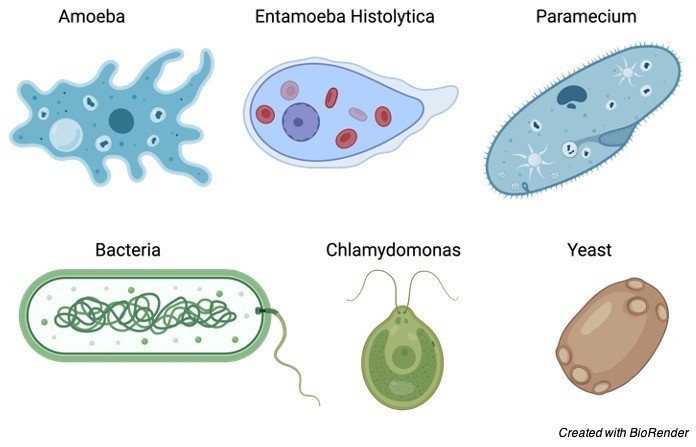Table of Contents
Unicellular Definition
Single-celled organisms are called as Unicellular. Such organisms can also carry out various function such as digestion, absorption, metabolism, excretion and reproduction, with the help of a single cell. Organisms can be unicellular prokaryote and unicellular eukaryote. Bacteria, archaea, protists and fungi are some example of unicellular organism. They can be opportunistic and cause various disease in plants, humans and animals. They have applications in environmental science as well as in medicine.
Unicellular organism contains protoplasm which possess various components such as nucleic acid, proteins, carbohydrates and others. The external and internal components of the organism are separated by cell membrane which is encapsulated by protoplasm; however, interaction is necessary to obtain food and to throw out unnecessary components. Although such organism are single-celled, they cannot be seen with the naked eyes and these unicellular organism can thrive in extreme conditions such as pH, temperature and cold conditions.
Unicellular Organism Examples
a) Phytoplankton: They are found in fresh water and marine water. They are protists which are unicellular. Examples are Diatoms and green algae. When favorable conditions are present, they blossom up, thus, producing large amount of oxygen. They get energy from photosynthesis.
b) Amoeba: They are found within human, dead matter, muddy soil and etc. Amoeba are eukaryotes. They have tentacles also known by the name pseudopods which helps to hunt prey, for locomotion and for other senses.

c) Nitrosomonas and Nitrobacter: These are prokaryotic. They produce a form of nitrogen from carbon or carbon dioxide. The other form of nitrogen is oxidized to form Nitrosomonas. That again gets oxidized to form Nitrobacter. It has applications in agriculture.
d) Euglena: It is a prokaryotic unicellular organism. They are autotrophs as well as heterotrophs. They are known as plant- animal hybrid. They can carry out photosynthesis if they get good amount of light, if not they obtain food from another organism.
Importance of Unicellular Organism
They are of great importance in the field of medicine, for the production of capsules, tablets and others. They also have importance in maintaining the equilibrium of the ecosystem.
i. Ecological Function of Unicellular Organism
Eubacteria have the ability to degrade organic matter, as well as fix the soil content. Pseudomonas species can combat pollution by breaking down the pollutants present in water and soil. Other than Pseudomonas, there are other species also capable of breaking down the pollutant. They have medicinal as well as industrial importance. For example, in making of alcohol, bread, cheese and other consumable products. Antibiotic formulation is another example. Another type of eubacteria is cyanobacteria which can carry out photosynthesis and balance the oxygen level.
ii. Medicinal Importance of Unicellular Organism
Unicellular organism such as archaea also have medicinal importance, such as antibiotic formulation., which are used to cure patients and to clear the resistance issue of the medication.
Types of Unicellular Organism
Unicellular organism can be both unicellular prokaryotes as well as unicellular eukaryotes, which are not visible to the naked and requires a microscope, although their colonies are visible to human eye.
i. Prokaryotes
Prokaryotes are those which lacks nucleus and organelles. The DNA is present in the nucleoid region. Examples are archaea and eubacteria. A way to distinguish between both is that eubacteria have peptidoglycan, whereas the other have pseudopeptidoglycan.
a) Archaea
They are the first found organism on earth. They thrive in extreme climatic conditions such as extreme temperature, methane derived conditions as well as in soil, water and other habitats. The mode of reproduction is binary fission and fragmentation. There is a type of archaea that produces methane are called as methanogens. They take up carbon dioxide to form methane and an energy molecule along with-it. Example ATP.
b) Eubacteria
Also referred to as true bacteria, which can be classified into classes; gram positive and gram negative on the basis of cell wall. In order to protect themselves from outer environment destruction, they produce spores. The mode of reproduction is binary fission and can be opportunistic as well as naturally present in the human microbiota to produce vitamins for the functioning of cells.
ii. Eukaryotes
They contain nucleus as well as organelles like mitochondria, chloroplast and others. They can reproduce sexually as well as asexually. Example of unicellular eukaryotes are Fungi and Protist.
a) Protist
They are unicellular eukaryotes, present in soil and in water. Examples are algae, water molds, protozoans, slime molds. Protozoans can be opportunistic, causing disease in humans such as Plasmodium falciparum causing malaria in humans. They can also be found in the body as natural microbiota. Photosynthesis can be carried out by few protozoans who can make their own food. The mode of reproduction in these parasites are binary fission, budding, schizogony, with a complex life cycle. However, few of them can sexually reproduce. In order to protect themselves from the outer environment, they have capsules.
• Algae: Single-celled organism which can synthesize their own food. They are seen in water, soil, rocks and other areas.
• Molds: Molds survive on dead decayed matter and are found in water which are known as water molds and in appearance are like fungi. When found on surface, they are called as slime molds, which under stress can convert into a multicellular entity.
b) Fungi
They can be unicellular as well as multicellular. Example of unicellular fungi are yeast, present on fruits, dried leaves and in food. It can also turn into opportunistic and cause disease such as Candida albicans, a fungal disease. Yeast can thrive in anaerobic as well as aerobic conditions. The mode of reproduction can be through binary fission and budding.
In anaerobic conditions, it leads to fermentation, thus forming products such as cheese, wine, bread and other dairy products. Fungi have the potential to degrade organic matter and thus form a part of the food chain. They also medicinal importance and culinary importance. For example, mushrooms are consumed world-wide. They also have a role to play in the ecology, the water reaches the roots of the plants when fungi takes up the water and passes it to the roots.
History of Unicellular Organism
Although the organelles present within the cell have same function such as within the nucleus is the DNA present, the energy sources are ATP. This happens due to evolution. However, variations will arise when organism tries to adapt to the unsuitable conditions.
There are three types of domains which are Bacteria, Archaea and Eukaryotes. 3.5 billion years prior, the first unicellular prokaryote fossil was obtained. According to the Endosymbiotic theory, from the prokaryotes, eukaryotes have emerged. This is due to resemblance in the organelles and various functions between the two.
Unicellular Organism Citations
- N 6-methyladenine DNA modification in the unicellular eukaryotic organism Tetrahymena thermophila. Eur J Protistol . 2017 Apr;58:94-102.
- Saccharomyces cerevisiae in neuroscience: how unicellular organism helps to better understand prion protein? Neural Regen Res . 2021 Mar;16(3):489-495.
- Tetrahymena as a Unicellular Model Eukaryote: Genetic and Genomic Tools. Genetics . 2016 Jun;203(2):649-65.
Share












